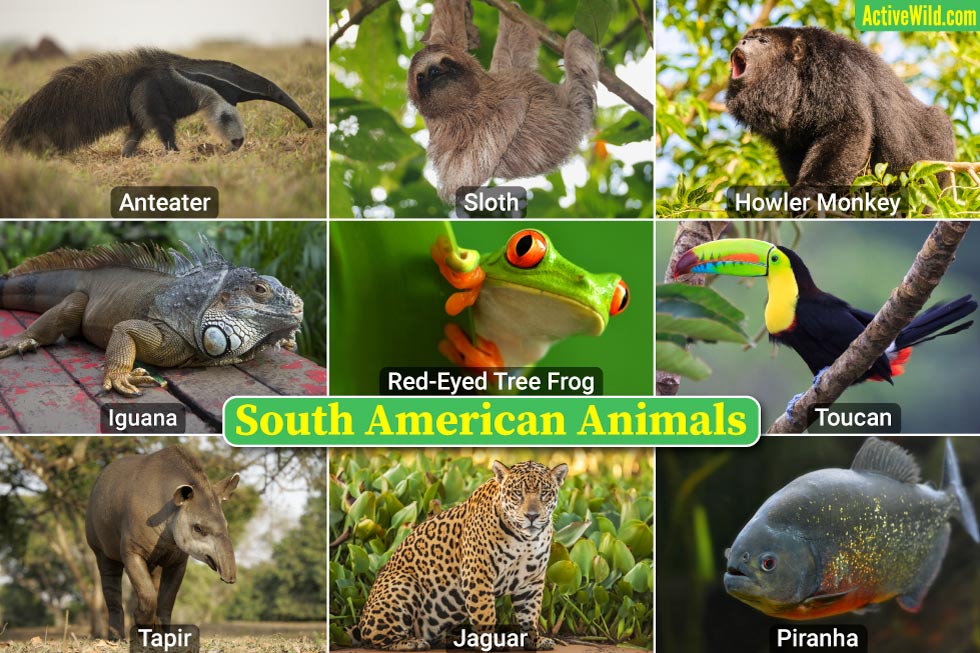South America is a continent known for its high biodiversity. Its rainforests, grasslands, mountains and deserts are home to a vast number of species, many of which are found nowhere else on Earth.
South American animals include mammals such as anteaters, tapirs, jaguar, maned wolf, howler monkeys and spider monkeys; reptiles such as caimans, anacondas and iguanas; amphibians such as poison dart frogs and the red-eyed tree frog; and birds such as the harpy eagle, rheas and macaws.
On this page is a list containing these and many other animals that live in South America, with pictures, facts, and links to further information on each.
South American Animal Habitats
South America is home not just to the world’s largest, and most famous rainforest – the Amazon Rainforest, but also to other important rainforests, including the Atlantic Rainforest and the mountainous cloud forests of northwestern South America.
Other important South American wildlife locations include the Pantanal – a vast tropical wetland; the Cerrado – a tropical savanna in Brazil; the Pampas – an expanse of grasslands in the southeast; the Andes – a mountain range that stretches along the continent’s western edge, the Atacama Desert, which lies in the rain shadow of the Andes; and the Galápagos Islands, located off the coast of Ecuador.
In the list below, you'll discover some of South America's most amazing animals from these and other locations.
Scroll down to see pictures and facts on all of the animals, or use the index below to go directly to a particular animal.
South American Animals
- Amazon River Dolphin
- Anaconda
- Anteater
- Argentine Horned Frog
- Blue Footed Booby
- Blue Morpho Butterfly
- Boa Constrictor
- Caiman
- Capybara
- Coatimundi (Coati)
- Giant Otter
- Goliath Birdeater
- Guanaco
- Harpy Eagle
- Hercules Beetle
- Howler Monkey
- Iguana
- Jaguar
- Llama
- Macaw
- Maned Wolf
- Piranha
- Poison Dart Frog
- Red Eyed Tree Frog
- Rhea
- Sloth
- Spectacled Bear
- Spider Monkey
- Tamarin
- Tapir
- Toucan
- Vicuña
Discover Amazing Animals From All Around The World
- African Animals
- Antarctic Animals
- Arctic Animals
- Asian Animals
- Australian Animals
- European Animals
- North American Animals
Amazon River Dolphin (Boto)

- Type of Animal: Mammal
- Family: Iniidae
- Scientific Name: Inia geoffrensis
- Conservation Status: Endangered
River dolphins are a group of dolphins that live in freshwater and brackish habitats. (Brackish water is a mixture of fresh water and sea water.) Although river dolphins are found in both South America and Asia, the two groups are not closely related.
The Amazon river dolphin, also known as the boto or pink river dolphin, is the largest river dolphin species. It is found in the Amazon River and its tributaries.
As an Amazon river dolphin matures, its skin changes from gray to pink in color, resulting in the species’ alternative name of “pink river dolphin”.
The Amazon river dolphin is closely related to the Bolivian, Orinoco and Araguaian river dolphins (all of which are found in South America); some scientists consider some or all of these dolphins to be subspecies of the Amazon river dolphin, rather than separate species.
Discover More With Active Wild
You can find out more about the Amazon river dolphin on this page: Amazon River Dolphin Facts
Discover more freshwater animals on this page: Freshwater Animals List with Pictures & Facts
Anaconda
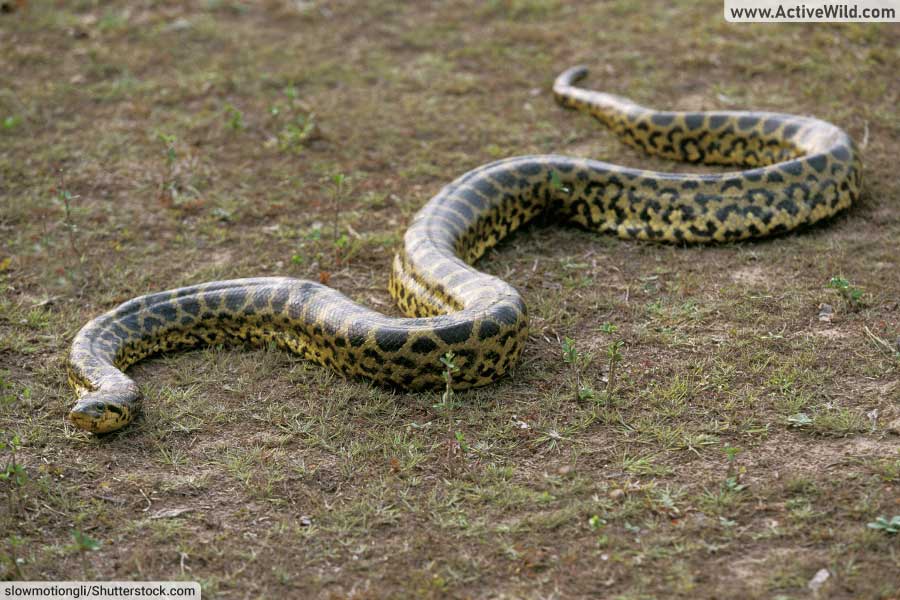
- Type of Animal: Reptile
- Family: Boidae
- Genus: Eunectes
There are four species of anaconda, all of which are found in South America. All belong to the genus Eunectes, which is part of the Boidae family (which is also home to Boa constrictor).
The green anaconda is the largest and best-known anaconda; the species is the world’s largest living snake by weight.
The other anaconda species are: the yellow anaconda, which is found from the Pantanal region to northern Argentina; the Bolivian anaconda; and the dark-spotted anaconda found in northeastern South America.
All four anacondas are large, non-venomous, constricting snakes that live in aquatic habitats.
Discover More With Active Wild
You can find out more about the green anaconda on this page: Green Anaconda Facts
Discover more rainforest reptiles on this page: Rainforest Reptiles Pictures & Facts
Anteater
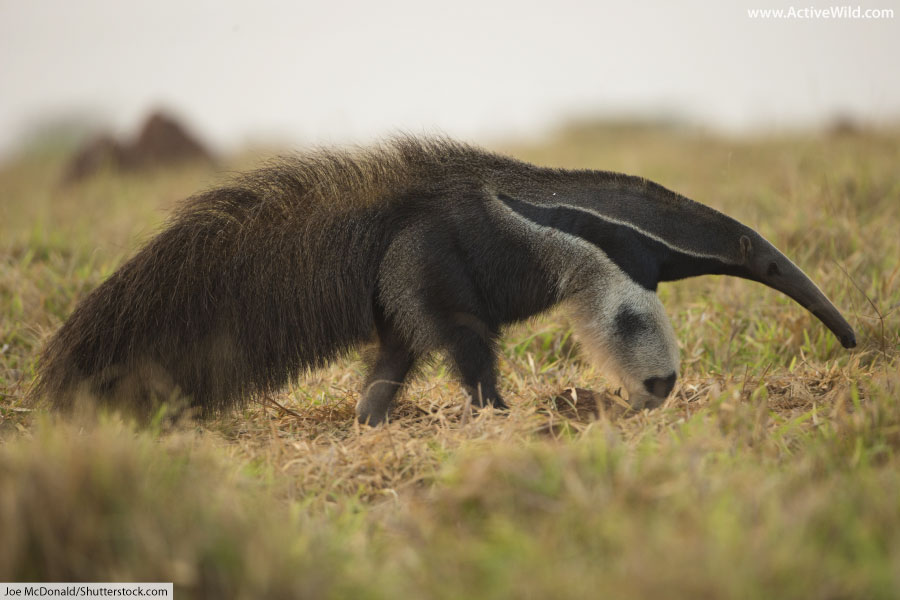
- Type of Animal: Mammal
- Suborder: Vermilingua
There are four species of anteater: the giant anteater, silky anteater, northern tamandua and southern tamandua. All are found in South America (all but the southern tamandua are also found in Central America).
The scientific name and conservation status of each anteater species is listed below:
- Giant anteater, Myrmecophaga tridactyla, Vulnerable
- Silky anteater, Cyclopes didactylus, Least Concern
- Northern tamandua, Tamandua mexicana, Least Concern
- Southern tamandua, Tamandua tetradactyla, Least Concern
As the name suggests, an anteater’s diet consists almost entirely of small insects, in particular ants and termites.
An anteater has a specially-modified, long, thin, and sticky tongue with which it captures its insect prey.
(Vermilingua, the group of mammals to which all anteaters belong, means “worm-tongue”.)
The largest anteater species, the giant anteater, is terrestrial (ground-dwelling), while the other three are arboreal (tree-dwelling). The arboreal anteaters have prehensile (capable of gripping) tails for holding onto branches while they are climbing.
Anteaters belong to the superorder Xenarthra, which is also home to sloths and armadillos.
Discover More With Active Wild
You can find out more about anteaters on this page: Anteater Facts
You can find out more about the giant anteater on this page: Giant Anteater Facts
Argentine Horned Frog
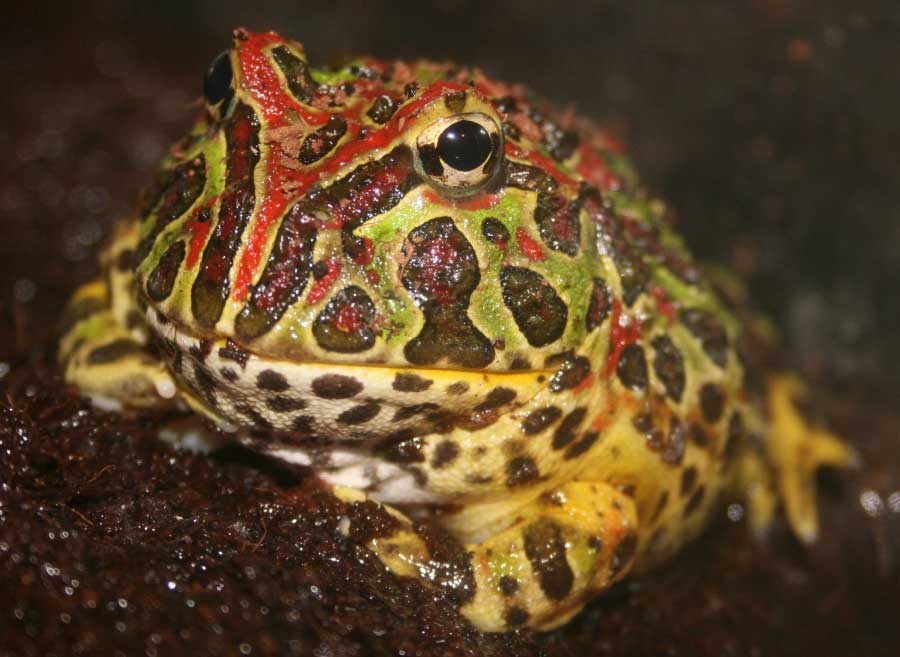
- Type of Animal: Amphibian
- Family:
- Scientific Name: Ceratophrys ornata
- Conservation Status: Least Concern
The Argentine horned frog is a striking-looking amphibian, due to its brightly-colored, patterned skin, horn-like projections above its eyes, and a huge mouth, which accounts for around half of the animal’s size.
This South American amphibian is a voracious predator, and will eat almost anything that it can fit into that enormous mouth; even mammals and other frogs.
The species’ huge mouth and big appetite has led to the frog’s alternative name: the ornate pacman frog!
Discover More With Active Wild
Discover more South American amphibians on this page: South American Amphibians
You can find out more about amphibians on this page: Amphibians - The Ultimate Guide
Blue Footed Booby
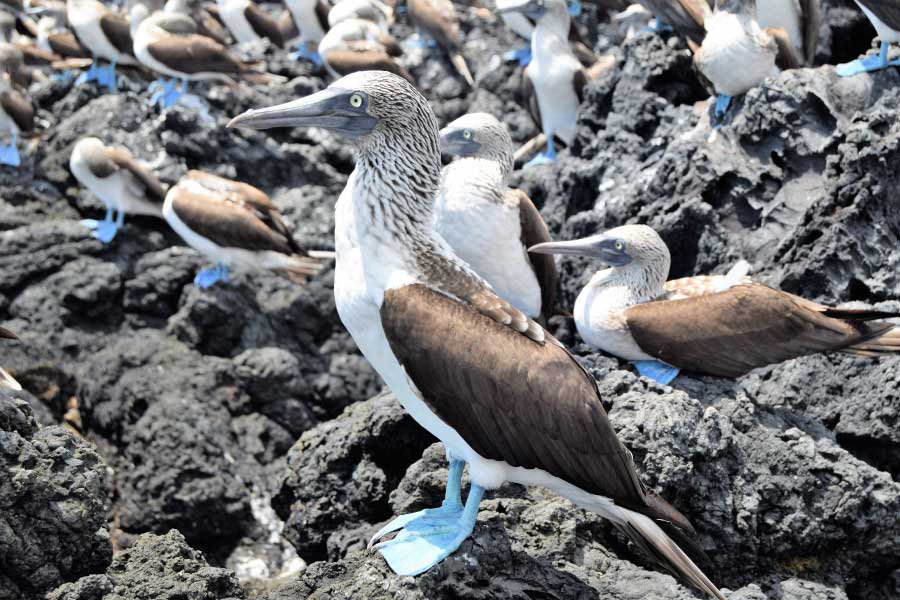
- Type of Animal: Bird
- Family: Sulidae
- Scientific Name: Sula nebouxii
- Conservation Status: Least Concern
The blue-footed booby is a distinctive seabird found off the Pacific coasts of South America and southern North America. Around half of all blue-footed boobies breed on the Galápagos Islands, an archipelago situated in the Pacific Ocean west of Ecuador.
The male bird uses its bright blue feet to attract females during the mating season, lifting each foot in turn in a courtship dance. If the female is impressed, she will join in the dance and mating will ensue.
The blue-footed booby is one of six boobies. Together, they make up the genus Sula. Sula is part of the family Sulidae, which is also home to gannets.
Discover More With Active Wild
Find out more about birds on this page: Birds – The Ultimate Guide
You can find out more about the different types of birds on this page: Types of Birds
Blue Morpho Butterfly
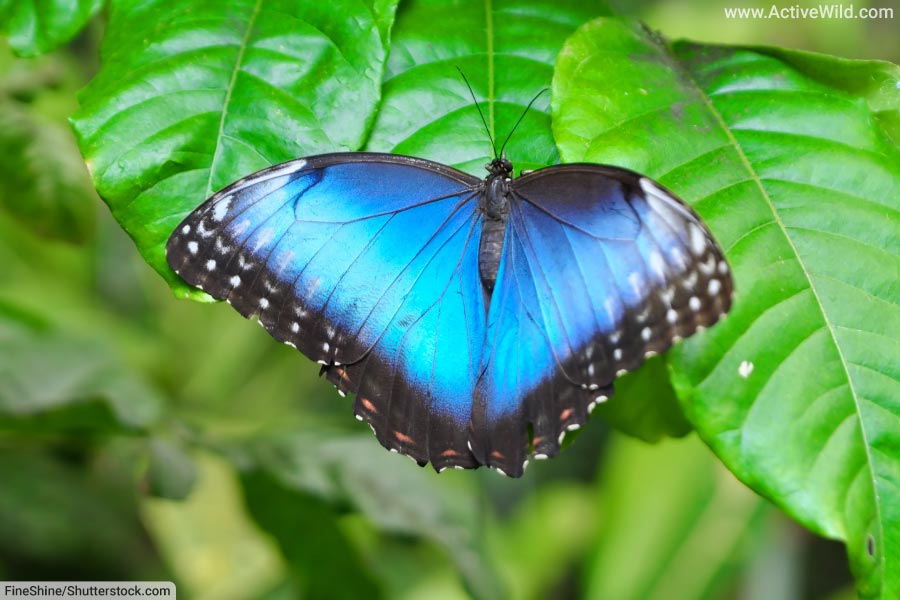
- Type of Animal: Insect
- Family: Nymphalidae
Blue morphos are large, bright blue butterflies found in South America (and southern parts of North America).
Several butterfly species of genus Morpho are known as “blue morphos”. These include the Menelaus blue morpho (Morpho menelaus), a species found in Central and South America with a 12 cm wingspan and iridescent blue wings.
Discover More With Active Wild
You can find out more about the blue morpho on this page: Blue Morpho Facts
Discover more about insects: Insects – The Ultimate Guide
Find out why insects are animals: Are Insects Animals?
Boa Constrictor
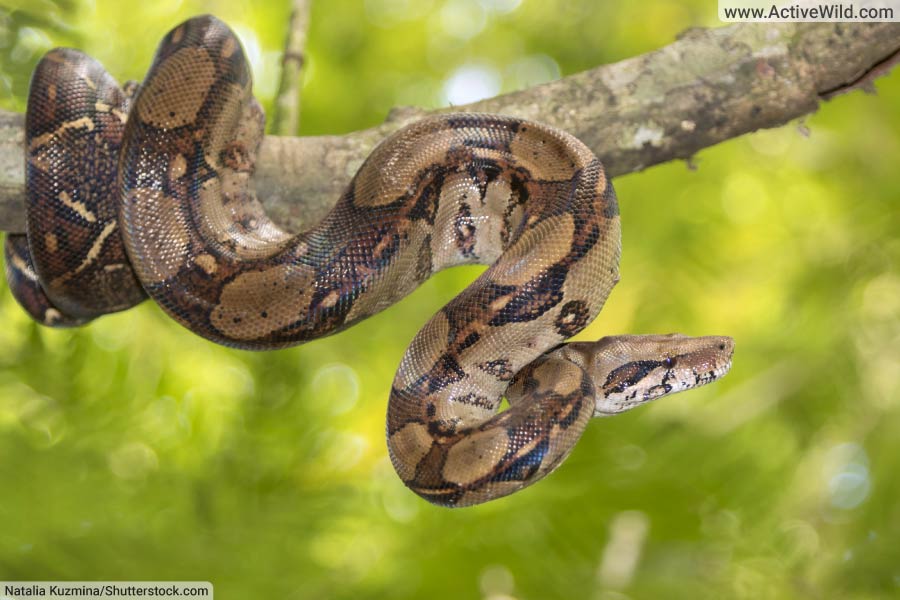
- Type of Animal: Reptile
- Family: Boidae
- Scientific Name: Boa constrictor
- Conservation Status: Least Concern
The boa constrictor is a large snake found in South and Central America (an introduced population also exists in Florida).
The species is one of the few animals who are commonly known by their scientific name.
Like all constrictors, the boa constrictor is non-venomous, and instead subdues its prey by coiling itself around its victim and squeezing with its muscular body.
Young boa constrictors spend much of their time in the trees, but as it gets older (and larger), the snake spends more of its time on the forest floor.
Discover More With Active Wild
Find out more about boa constrictors here: Boa Constrictor Facts
Discover more amazing snakes on this page: Types of Snakes
Become a reptile expert: Reptiles – The Ultimate Guide
Caiman
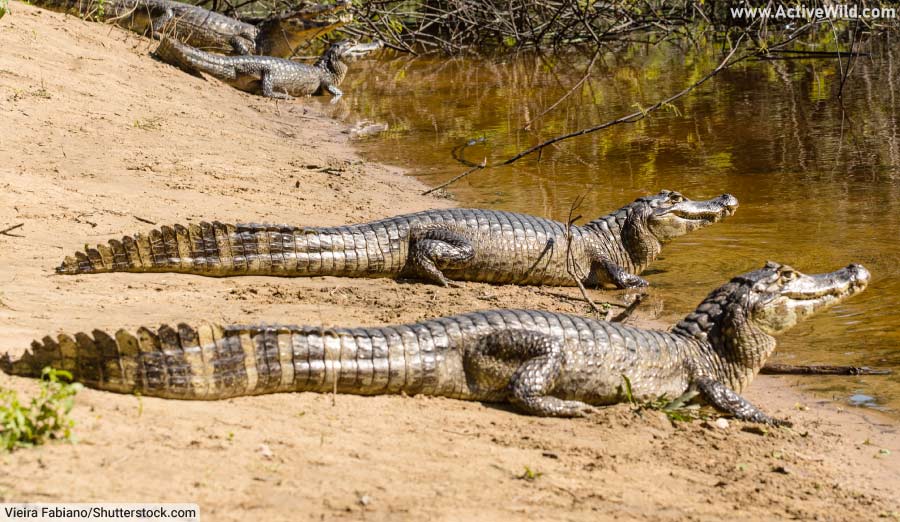
Type of Animal: Reptile
Family: Alligatoridae
Caimans are crocodilians belonging to the subfamily Caimaninae, which is part of the alligator family Alligatoridae (which is also home to alligators).
There are six species of caiman. They range in size from the 1.4 m / 4.6 ft Cuvier’s dwarf caiman to the 5 m / 16 ft-plus black caiman, which is the largest member of the alligator family.
The spectacled caiman, the most common crocodilian, is found from central South America to as far north as Mexico; all of the other caimans are found only in South America.
Discover More With Active Wild
You can find out more about caimans on this page: Caiman Facts
You can find out more about the spectacled caiman on this page: Spectacled Caiman Facts
Capybara
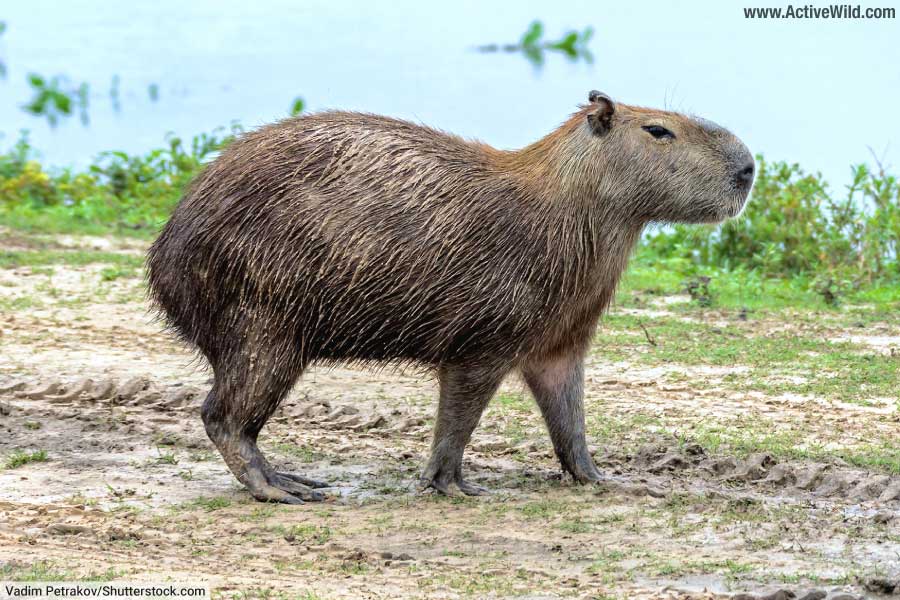
- Type of Animal: Mammal
- Family: Caviidae
- Scientific Name: Hydrochoerus hydrochaeris
- Conservation Status: Least Concern
The capybara is the world’s largest rodent, growing to around the size of a Labrador retriever. This freshwater mammal is found throughout much of South America (all countries apart from Chile) and into Central America. Escapee capybaras have also been found in Florida.
The capybara is semiaquatic, and never found far from water. Its toes are slightly webbed for swimming, and it can stay underwater for up to five minutes.
Discover More With Active Wild
You can find out more about capybaras on this page: Capybara Facts
Discover more about rodents on this page: Rodents - The Ultimate Guide
You can find out more about freshwater animals on this page: Freshwater Animals
Coatimundi (Coati)
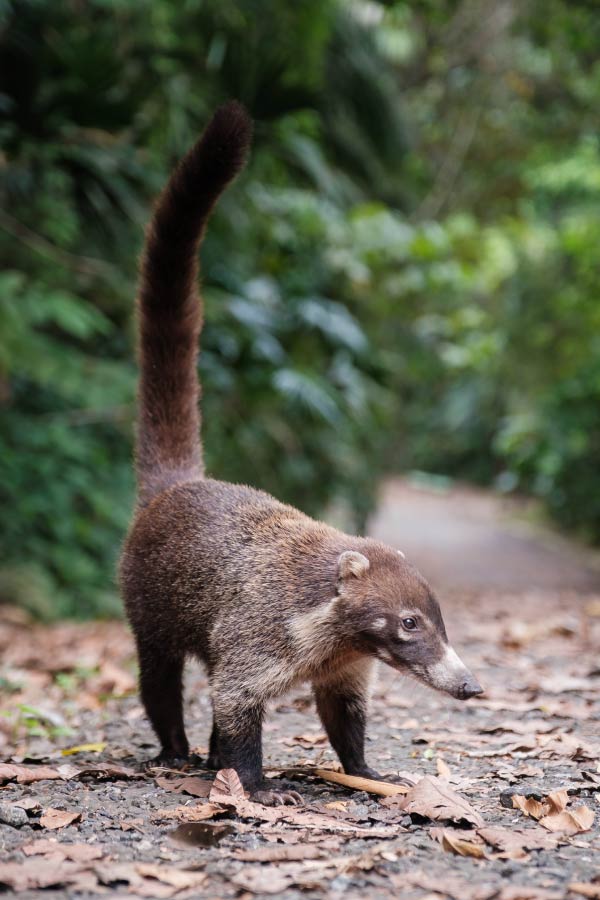
- Type of Animal: Mammal
- Family: Procyonidae
Coatimundis are cat-sized omnivorous mammals belonging to the raccoon family, Procyonidae. They are commonly known as “coatis”.
There are four species of coatimundi: white-nosed, South American, eastern mountain and western mountain. All are found in South America; the range of the white-nosed coati extends as far north as the southern United States.
Coatis forage on the forest floor by day, finding food among the leaf litter using their acute sense of smell. During the night they sleep in the forest canopy.
Discover More With Active Wild
You can find out more about the South American coati on this page: South American Coati Facts
Giant Otter

- Type of Animal: Mammal
- Family: Mustelidae
- Scientific Name: Pteronura brasiliensis
- Conservation Status: Endangered
The giant otter is a carnivorous mammal that inhabits the rainforests of South America. It is not only the largest otter, but also the largest member of the weasel family, Mustelidae.
Like all otters, the giant otter has a semi-aquatic lifestyle, with fish making up the bulk of its diet. It is found in the Amazon River and its tributaries, and in the Pantanal.
Habitat loss and over-hunting have caused the giant otter to become endangered, and it is now found in only one-fifth of its original range.
Discover More With Active Wild
You can find out more about the giant otter on this page: Giant Otter Facts
Goliath Birdeater
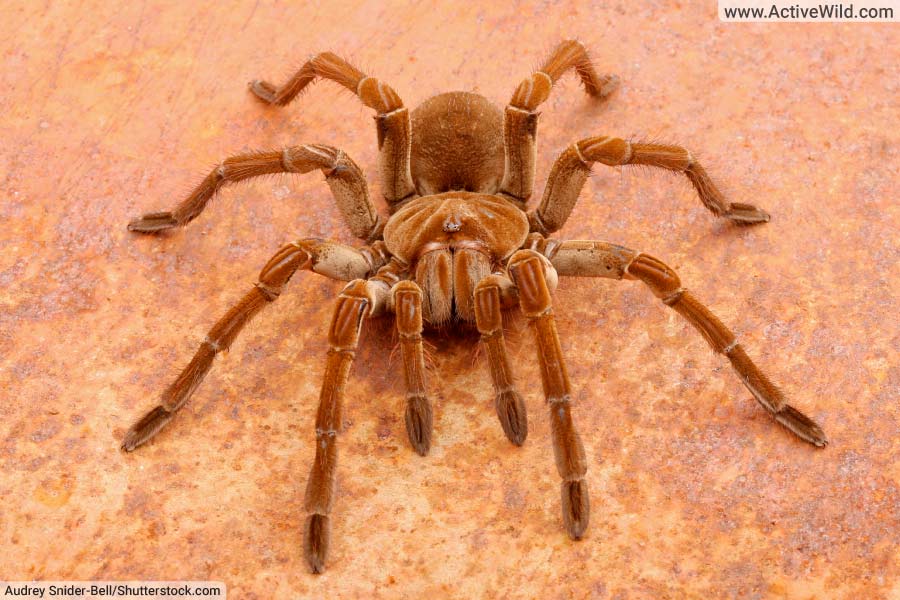
- Type of Animal: Arachnid
- Family: Theraphosidae
- Scientific Name: Theraphosa blondi
- Conservation Status: Unassessed
The goliath birdeater is the world’s largest spider in both weight and length, although the giant huntsman spider, Heteropoda maxima, has a longer leg span. The goliath birdeater is a member of the tarantula family, Theraphosidae.
This large arachnid is found in the rainforests of South America. Despite its name, the goliath birdeater rarely preys on birds. Instead, it mainly hunts earthworms and toads, but will also eat many other types of small animal. Its bite is venomous, but generally not harmful to humans.
Discover More With Active Wild
Discover more about spiders on this page: Is a Spider an Insect?
Find out more about arachnids on this page: Arachnids – The Ultimate Guide
You can see more rainforest animals on this page: Rainforest Animals List with Pictures & Facts
Guanaco
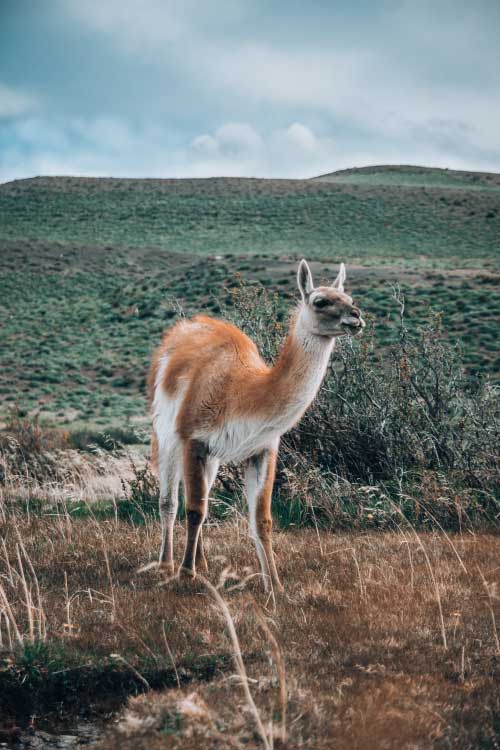
- Type of Animal: Mammal
- Family: Camelidae
- Scientific Name: Lama guanicoe
- Conservation Status: Least Concern
Camels are animals most often associated with the deserts of North Africa and the Middle East, but four of the seven members of the camel family Camelidae are found in South America.
The four South American camelids are listed below:
- Llama Lama glama
- Alpaca Vicugna pacos
- Guanaco Lama guanicoe
- Vicuña Vicugna vicugna
Whereas the llama and alpaca have been domesticated for hundreds of years, the guanaco and Vicuña are wild animals.
The guanaco lives in small herds in Patagonia and in the Andean plateau region of west-central South America. The species is thought to be ancestral to the closely-related llama.
Discover More With Active Wild
You can find out more about mammals on this page: Mammals - The Ultimate Guide
Harpy Eagle
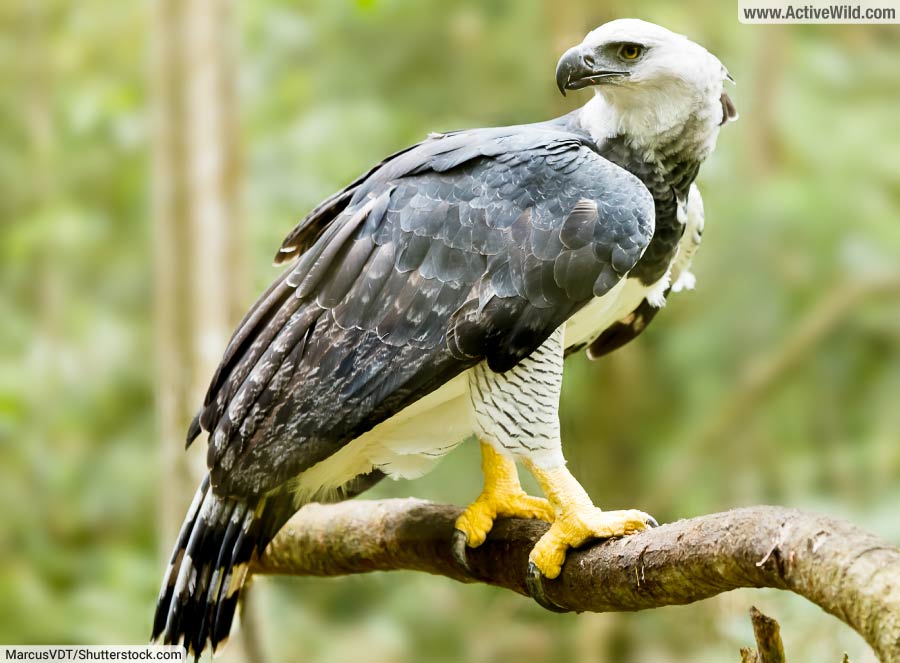
- Type of Animal: Bird
- Family: Accipitridae
- Scientific Name: Harpia harpyja
- Conservation Status: Near Threatened
The harpy eagle is one of the largest eagles in the world in terms of weight, although its wingspan is relatively small compared to those of other large eagles; this is an adaption for flying through the forest.
The largest harpy eagles weigh up to 9 kg / 19.84 lb. As with many birds of prey, the female is larger than the male.
The harpy eagle is said to be the world’s most powerful bird of prey. It is capable of plucking mid-sized mammals such as monkeys and sloths from out of trees.
Discover More With Active Wild
You can read more about the harpy eagle on this page: Harpy Eagle Facts
Hercules Beetle
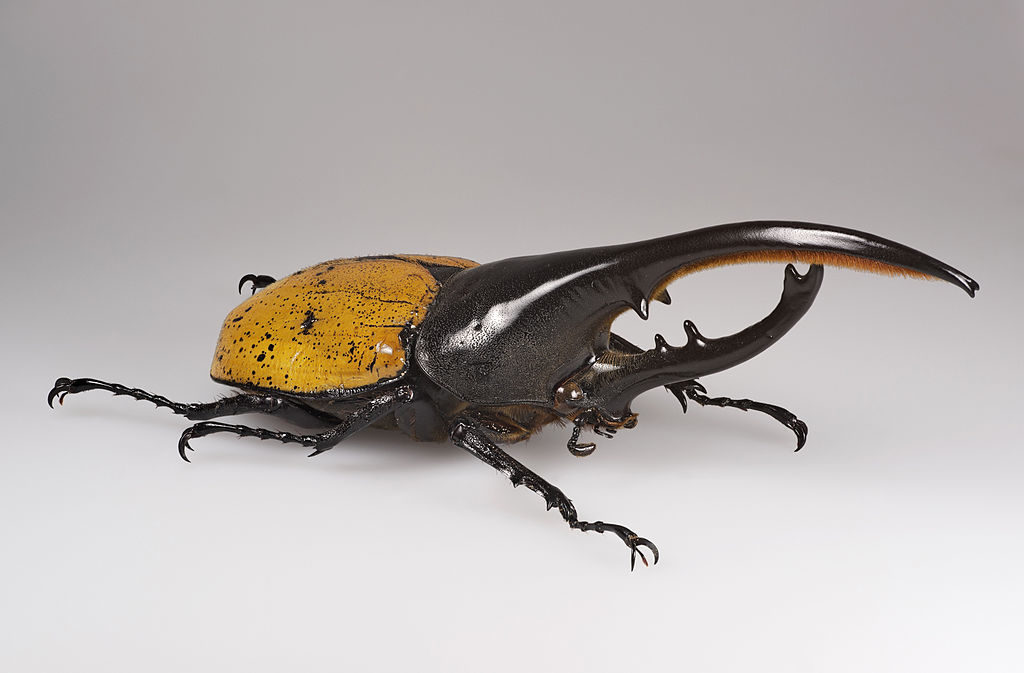
- Type of Animal: Insect
- Family: Scarabaeidae
- Scientific Name: Dynastes hercules
- Conservation Status: Unassessed
Reaching lengths of up to 7 in. / 17.78 cm, including its striking, elongated horn, the Hercules beetle is the world’s longest beetle. This giant insect can be found in rainforests from Bolivia to Mexico.
Only male Hercules beetles have an elongated horn, which is used in fights to establish mating rights with females.
Discover More With Active Wild
You can find out more about beetles on this page: Beetles - The Ultimate Guide
Howler Monkey
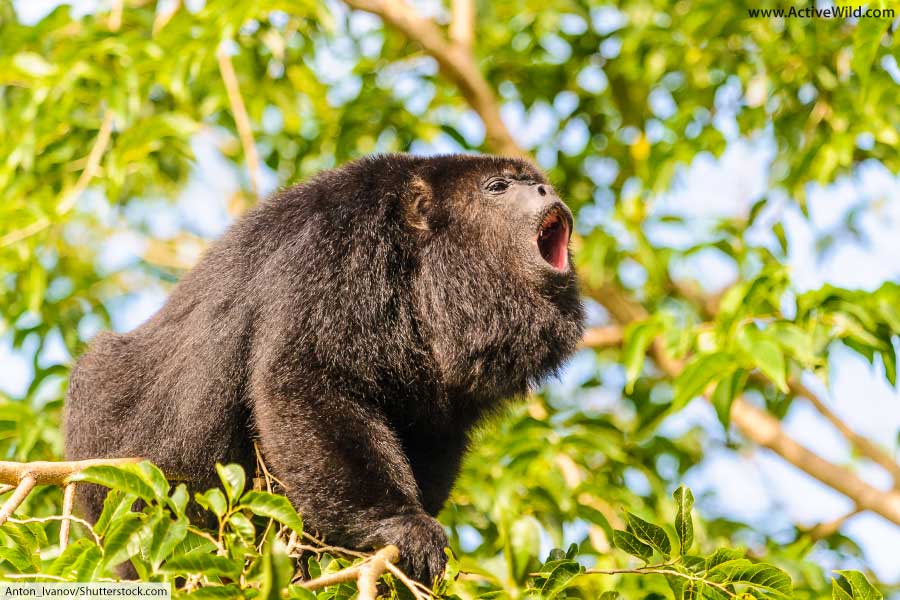
- Type of Animal: Mammal
- Family: Atelidae
- Genus: Alouatta
There are fifteen species of howler monkey. They make up the genus Alouatta, which is part of the family Atelidae, also home to spider monkeys, woolly monkeys, and woolly spider monkeys.
Troops of howler monkeys use their loud calls to announce their presence to other groups. This lessens the likelihood of fighting between the troops.
Howler monkeys are most likely to be heard at dawn. Their calls can be heard up to 5km / 3.11 miles away.
Discover More With Active Wild
You can find out more about monkeys on this page: Monkeys – The Ultimate Guide
Discover other types of monkeys on this page: Types Of Monkeys
Iguana (Green)
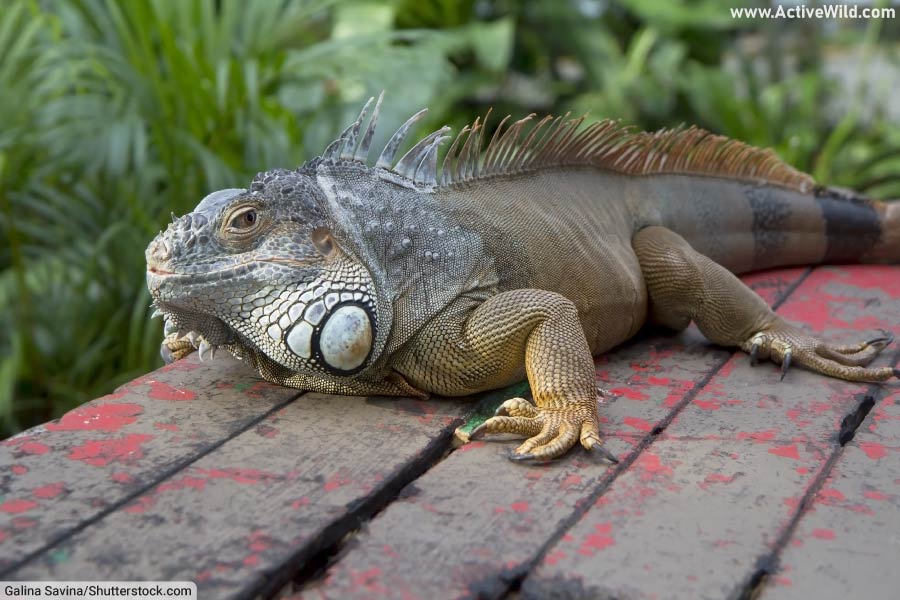
- Type of Animal: Reptile
- Family: Iguanidae
- Scientific Name: Iguana iguana
- Conservation Status: Least Concern
The green iguana is a large lizard found in forests in Central and South America. The species is commonly called the iguana, with its full name being used to distinguish it from other species in the iguana family, Iguanidae.
The green iguana’s closest relative is the critically endangered Lesser Antillean iguana, a species found on the Lesser Antilles islands in the Caribbean.
Despite its size (the species can reach lengths in excess of 2 m / 6.56 ft.) and fearsome looks, the green iguana is mainly herbivorous.
An arboreal (tree-dwelling) species, the green iguana is also an excellent swimmer. If threatened, it will often dive into a nearby body of water.
Discover More With Active Wild
You can find out more about iguanas on this page: Iguana Facts
Discover more amazing lizards on this page: Types of Lizards
Become a reptile expert: Reptiles – The Ultimate Guide
Jaguar

Type of Animal: Mammal
Family: Felidae
Scientific Name: Panthera onca
Conservation Status: Near Threatened
The jaguar is the third-largest member of the cat family, Felidae – only the tiger and the lion are bigger.
This big cat lives in the forests of Central and South America, where it is an apex predator (top of the food chain). The species is also (very) occasionally seen in the southern United States.
Like other big cats, the jaguar belongs to the genus Panthera. (The definition of “big cat” is also sometimes widened to include the cheetah and cougar, which do not belong to the genus Panthera.)
The jaguar is considered to be a keystone species. Keystone species are animals considered essential for keeping an ecosystem in balance; without their presence, the ecosystem will fail.
As apex predator, the jaguar plays an important role in controlling the numbers of prey animals in its environment.
Discover More With Active Wild
Discover more about the jaguar on this page: Jaguar Facts
You can see EVERY species of cat on this page: Wild Cats List with Pictures & Facts
Llama
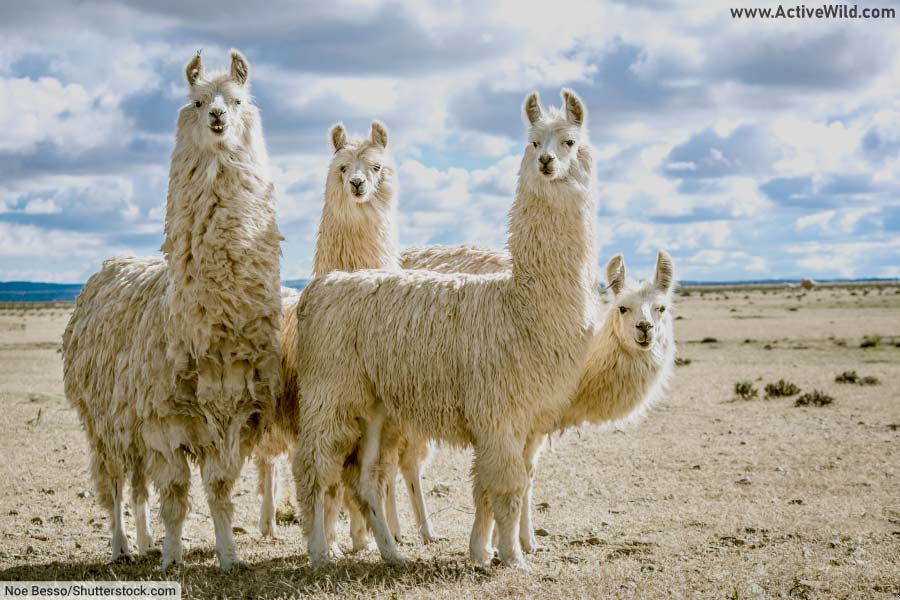
- Type of Animal: Mammal
- Family: Camelidae
- Scientific Name: Lama glama
- Conservation Status: Domestic
The llama is a domesticated member of the camel family, Camelidae. Its ancestors are the wild camelids, the guanaco and vicuña.
The llama was originally domesticated in South America over a thousand years ago; domestic llamas were used by the Incas.
Llamas are used as beasts of burden, and farmed for their meat and wool.
Discover More With Active Wild
You can find out more about mammals on this page: Mammals – The Ultimate Guide
Discover the different types of mammals on this page: Types Of Mammals
Macaw
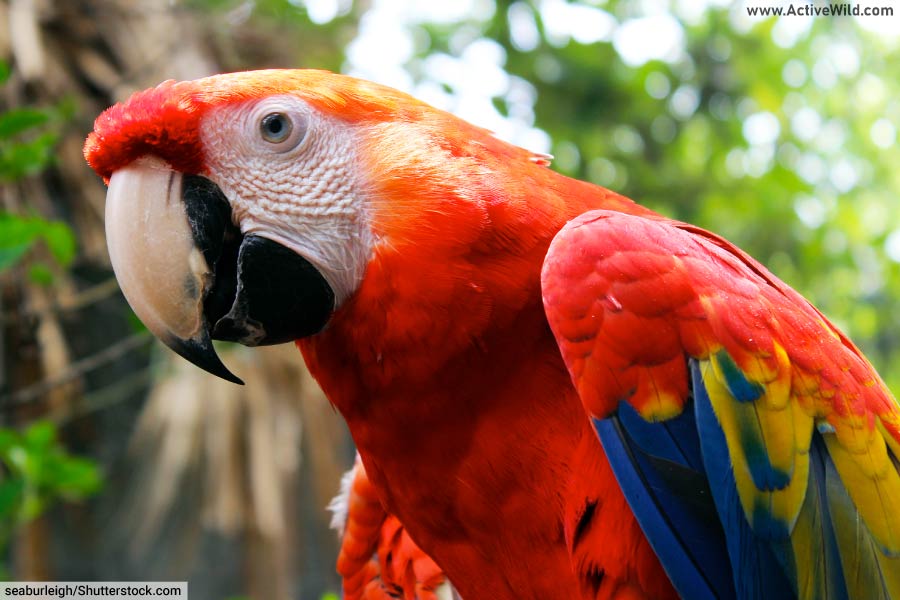
- Type of Animal: Bird
- Order: Psittaciformes
- Family: Psittacidae
Macaws are a group of parrots with large beaks, long tails, and featherless faces (macaws are known to blush when they’re excited). There are 17 living macaw species. These brightly-colored birds are native to Central and South America.
Macaws are popular pets due to their colorful appearance, inquisitive personalities and ability to mimic human speech. Unfortunately, the birds’ popularity has led to a dramatic decline in their wild populations, as they often fall prey to the illegal pet trade.
Macaws are social birds that form monogamous pairs. There is no sexual dimorphism between the sexes, which is somewhat uncommon among brightly-colored bird species.
Macaws are mainly herbivorous, eating different types of flowers, fruits, seeds and nuts. Their powerful beaks are specially adapted for cracking open hard plant material. Macaws are opportunistic feeders and will also eat eggs, small lizards and insects if the opportunity arises.
Discover More With Active Wild
Find out more about birds on this page: Birds – The Ultimate Guide
You can find out more about the different types of birds on this page: Types of Birds
Maned Wolf
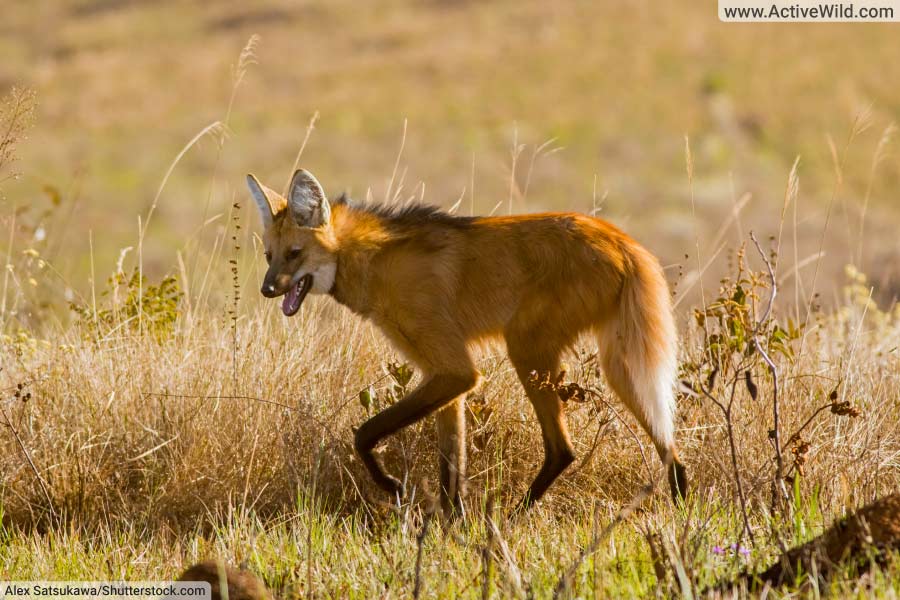
- Type of Animal: Mammal
- Family: Canidae (the dog family)
- Scientific Name: Chrysocyon brachyurus
- Conservation Status: Near Threatened
The maned wolf is a canid (member of the dog family, Canidae) found in the grasslands of central South America. It is both the largest canid found in South America, and the tallest of all wild dogs. This distinctive species has a shaggy, red-brown coat, long legs and large ears.
Discover More With Active Wild
You can see EVERY wild dog species on this page: Wild Dog Species List with Pictures & Facts
Discover more grassland animals on this page: Grassland Animals Pictures & Facts
Piranha
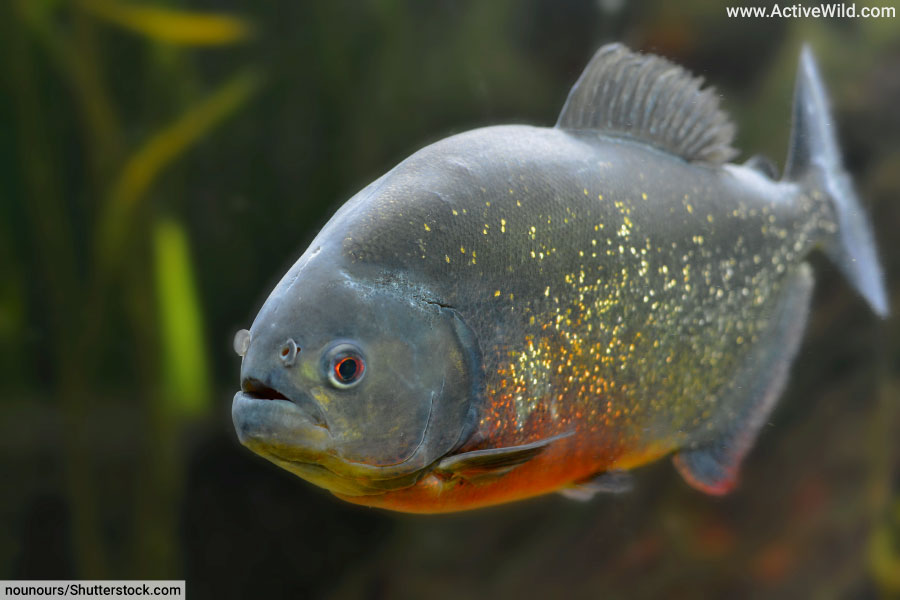
- Type of Animal: Fish
- Family: Serrasalmidae
Piranhas are freshwater fish found in rivers and lakes in South America.
Equipped with large teeth and powerful jaws, piranhas have a reputation as being fearsome predators. This is only partially true; most piranhas are omnivores, and are often themselves the prey of other freshwater animals such as caimans.
Piranhas will occasionally attack humans, but this usually results in nothing more than minor cuts to the hands or feet.
Discover More With Active Wild
You can find out more about piranhas on this page: Piranha Facts
You can find out more about fish on this page: Fish – The Ultimate Guide
Discover interesting fish from all around the world: Types of Fish
Poison Dart Frog
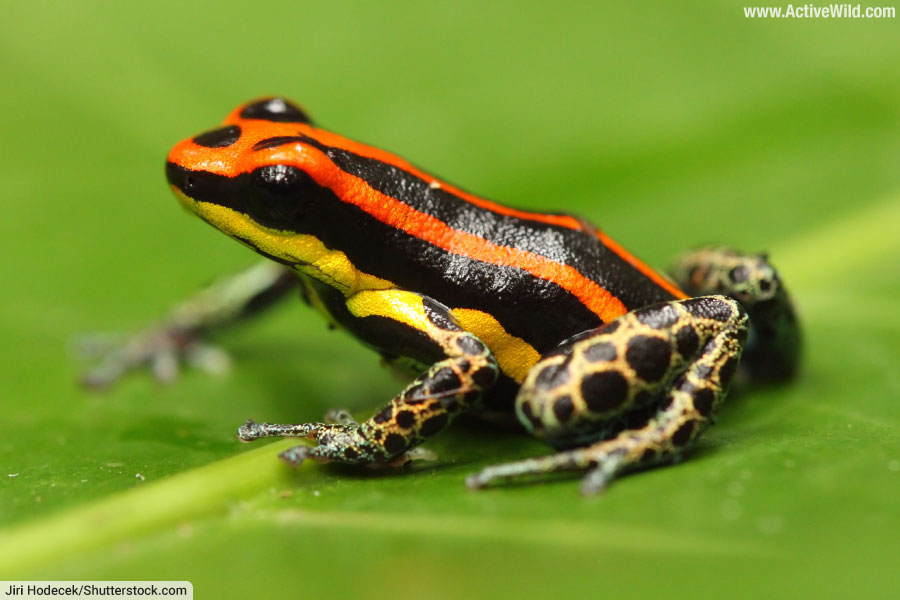
- Type of Animal: Amphibian
- Family: Dendrobatidae
Poison dart frogs are among the best-known of all South American amphibians. There are many different species of poison dart frog. Together, they make up the family Dendrobatidae, and are only found in Central and South America.
Poison dart frogs get their name from the poisons secreted by glands in their skin. Indigenous hunters would dip the tips of their darts in these poisons, making the weapons even more lethal.
The brightly-colored skin of a poison dart frog warns potential predators that it is poisonous (an adaption known as Aposematism).
Poison dart frogs such as the golden poison frog Phyllobates terribilis are among the most poisonous of all living animals. Just one golden poison frog contains enough poison to be lethal to up to 20 people!
Discover More With Active Wild
Discover amphibians from South America on this page: South American Amphibians
You can find out more about poison dart frogs on this page: Poison Dart Frog Facts
You can find out more about the golden poison frog on this page: Golden Poison Frog Facts
Red-Eyed Tree Frog
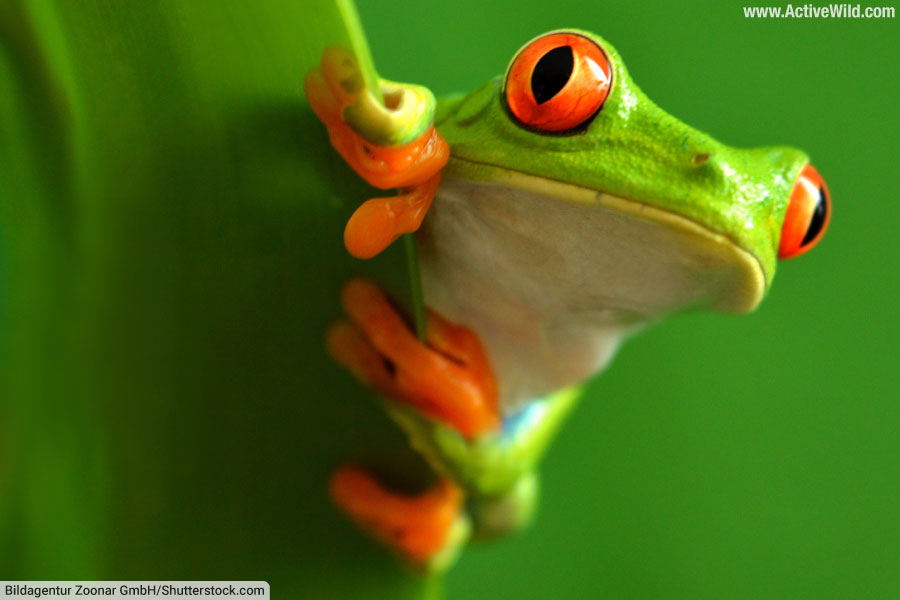
- Type of Animal: Amphibian
- Family: Hylidae
- Scientific Name: Agalychnis callidryas
- Conservation Status: Least Concern
The red-eyed tree frog is found in rainforests from southern Mexico to Columbia.
This brightly-colored amphibian lives in the rainforest canopy. Its green color provides camouflage from predators. If threatened by a predator, the frog will flash open its large red eyes and display its orange feet and blue stripes in an attempt to startle the aggressor.
Discover More With Active Wild
You can find out more about the red-eyed tree frog on this page: Red-Eyed Tree Frog Facts
Rhea
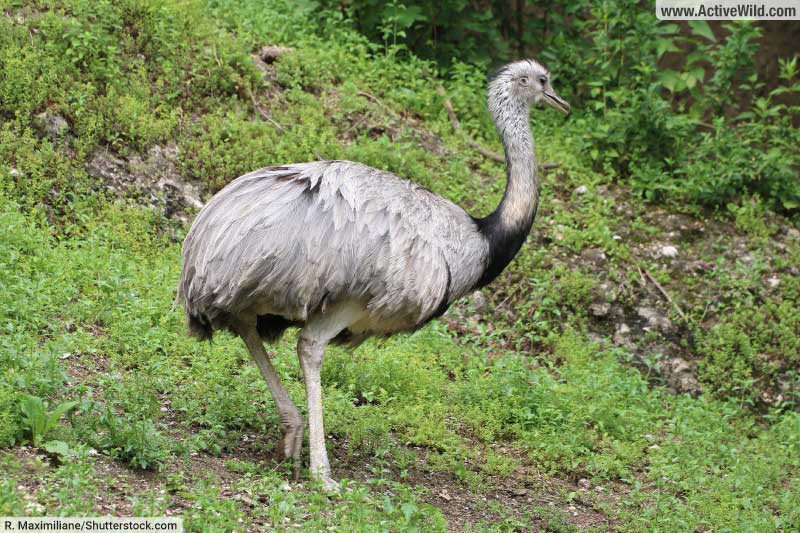
- Type of Animal: Bird
- Family: Rheidae
- Scientific Name: (Greater rhea) Rhea americana; (Lesser rhea) Rhea pennataI
- Conservation Status: (Greater rhea) Near Threatened; (Lesser rhea) Least Concern
There are two species of rhea: the greater rhea and lesser rhea (also known as Darwin’s rhea, ñandú petiso, or ñandú del norte). These large, flightless birds are found in grasslands and pampas in South America.
(Some authorities recognize a third rhea species, the Puna rhea Rhea tarapacensis.)
The greater rhea is the largest species of rhea, and the largest bird of the Americas. It can reach weights of 40 kg (88 lb.), and has an average body length of 1.34 m (4.4 ft.). The species is the world’s seventh-largest bird by weight.
(Although larger in size than the emperor penguin (the world’s sixth largest living bird), the greater rhea weighs less on average.)
Rheas are known to form mixed herds with deer and guanacos, a behavior thought to improve their chances of survival.
Discover More With Active Wild
You can see more grassland species on this page: Grassland Animals
Discover more about birds on this page: Birds – The Ultimate Guide
See different types of birds on this page: Types of Birds
Sloth
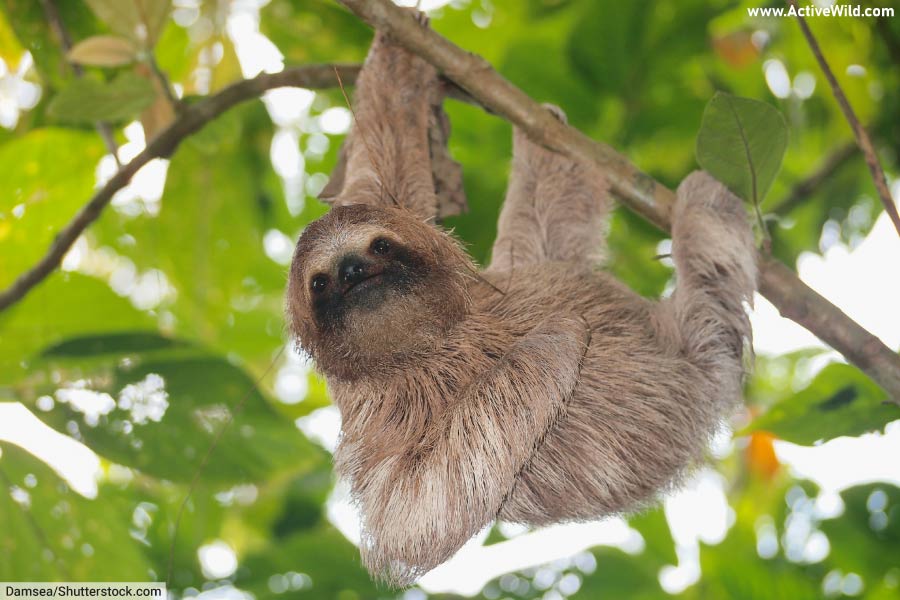
- Type of Animal: Mammal
- Suborder: Folivora
Sloths are among the best-known of all South American animals (several sloth species are also found in Central America). These arboreal (tree-dwelling) animals are known both for their habit of hanging upside-down from branches, and for the slowness of their movement.
Four of the six living sloth species are “three-toad sloths” of family Bradypodidae and genus Bradypus; the remaining two species are “two-toad sloths” of family Choloepodidae and genus Choloepus.
Three-toed sloths have three toes on their forelimbs, while two-toed sloths have two toes on their forelimbs. (All sloths have three toes on their hind limbs.)
The brown-throated sloth is the most common of the six living sloths. It is a three-toed sloth found in Central and South America. The species sleeps between 15 and 18 hours a day and only descends from the forest canopy around once a week in order to defecate.
Discover More With Active Wild
You can find out more about sloths on this page: Sloth Facts
Spectacled Bear
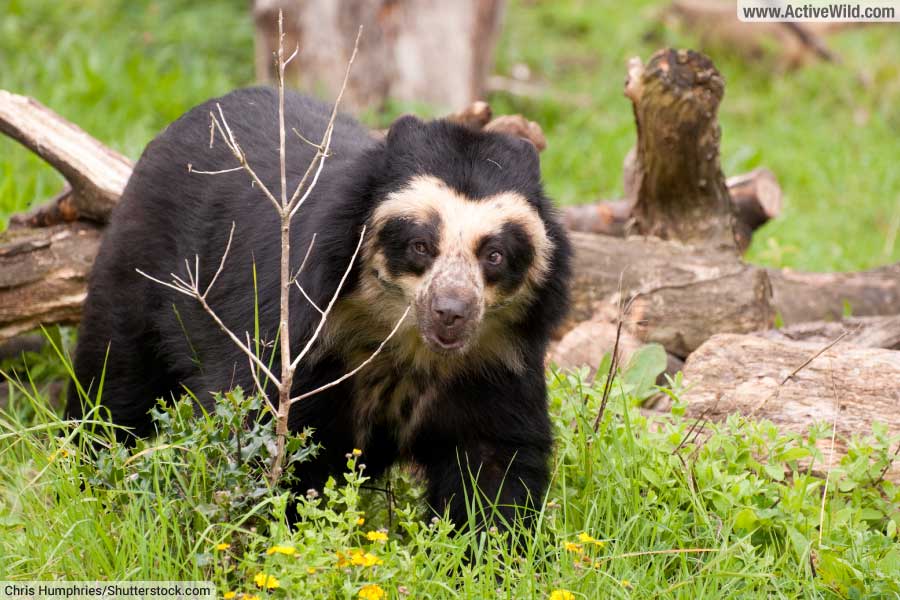
- Type of Animal: Mammal
- Family: Ursidae
- Scientific Name: Tremarctos ornatus
- Conservation Status: Vulnerable
The spectacled bear is the only bear species found in South America, and is found further south than any other bear. It is the only living member of the bear subfamily Tremarctinae (the short-faced bears), which includes fearsome prehistoric species such as the giant short-faced bear, considered one of the largest land carnivorans ever to have lived.
The spectacled bear is named for the spectacle-like appearance of its facial markings, which form a cross around the bear’s eyes. (Not all individuals have these pale orange-colored markings.)
Although meat makes up just a small percentage (around 10%) of the bear’s diet, the species is partly predatory, and as such is considered South America’s largest land carnivore.
The spectacled bear lives in South America’s Andes mountain range and is present in Venezuela to Bolivia.
Discover More With Active Wild
You can find out more about the spectacled bear on this page: Spectacled Bear Facts
Find out more about the different types of bears on this page: Types of Bears
Spider Monkey
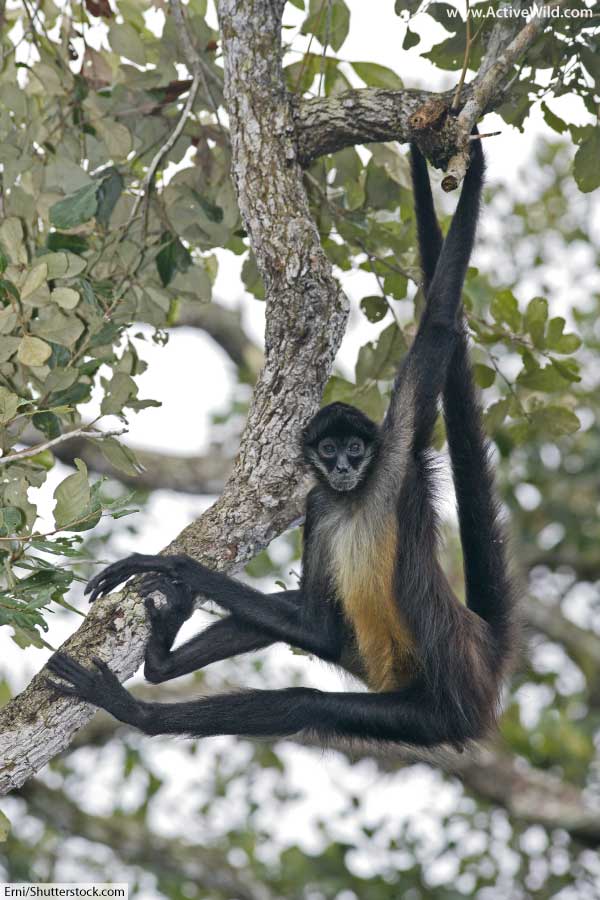
- Type of Animal: Mammal
- Family: Atelidae
- Genus: Ateles
Spider monkeys are a group of Central and South America monkeys with characteristically long, spider-like limbs and tails.
There are seven species of spider monkey (source) , together, they make up the genus Ateles.
The names and conservation status of each of the seven spider monkey species are listed below:
- White-bellied Spider Monkey (Ateles belzebuth) Endangered
- Peruvian spider monkey / Black-faced Black Spider Monkey (Ateles chamek) Endangered
- Brown-headed Spider Monkey (Ateles fusciceps) Endangered
- Geoffroy’s Spider Monkey (Ateles geoffroyi) Endangered
- Brown Spider Monkey / Variegated Spider Monkey (Ateles hybridus) Critically Endangered
- White-cheeked Spider Monkey (Ateles marginatus) Endangered
- Red-faced spider monkey / Guiana Spider Monkey (Ateles paniscus) Vulnerable
Spider monkeys are threatened by hunting (they are targeted by local people for their meat), and by deforestation.
Spider monkeys belong to the family Atelidae, a family of New World monkeys that also contains the howler monkeys, woolly monkeys, and woolly spider monkeys. In all, there are 29 species in the family Atelidae.
Spider monkeys live in untouched areas of rainforest in Central and South America.
Discover More With Active Wild
You can find out more about spider monkeys on this page: Spider Monkey Facts
Tamarin
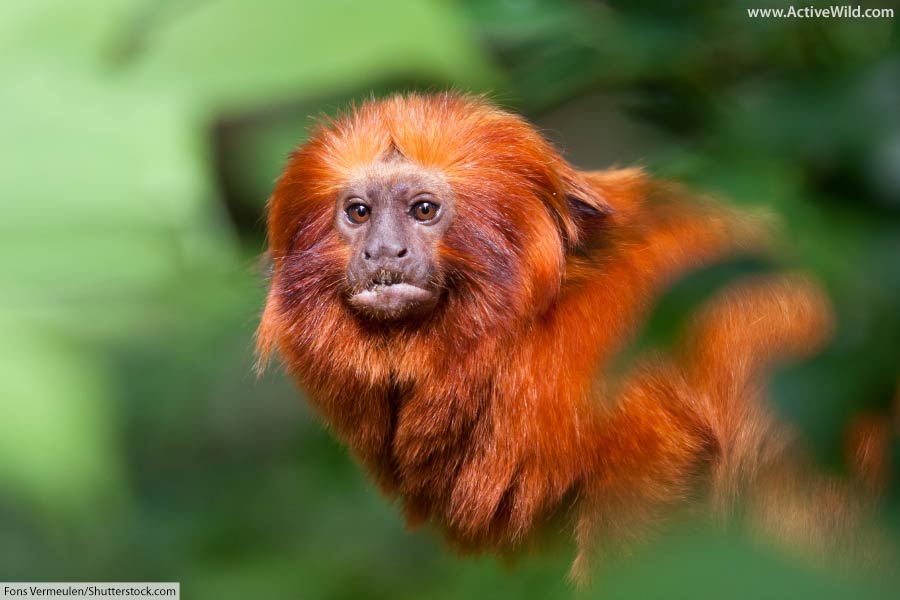
- Type of Animal: Mammal
- Family: Callitrichidae
- Genus: Saguinus
Currently, 22 species of tamarin are recognized. These small monkeys live in the trees of the tropical rainforests of Central and South America, with many species being found in the Amazon Rainforest.
Well-known tamarin species include the golden lion tamarin, with its striking golden coat, and the emperor tamarin, with its large white moustache.
Tamarins live in troops of between 3 and 40 individuals. They are known to exhibit both altruistic and spiteful behavior.
Discover More With Active Wild
You can find out more about monkeys on this page: Monkeys – The Ultimate Guide
Discover the different types of monkeys on this page: Types of Monkeys
Tapir
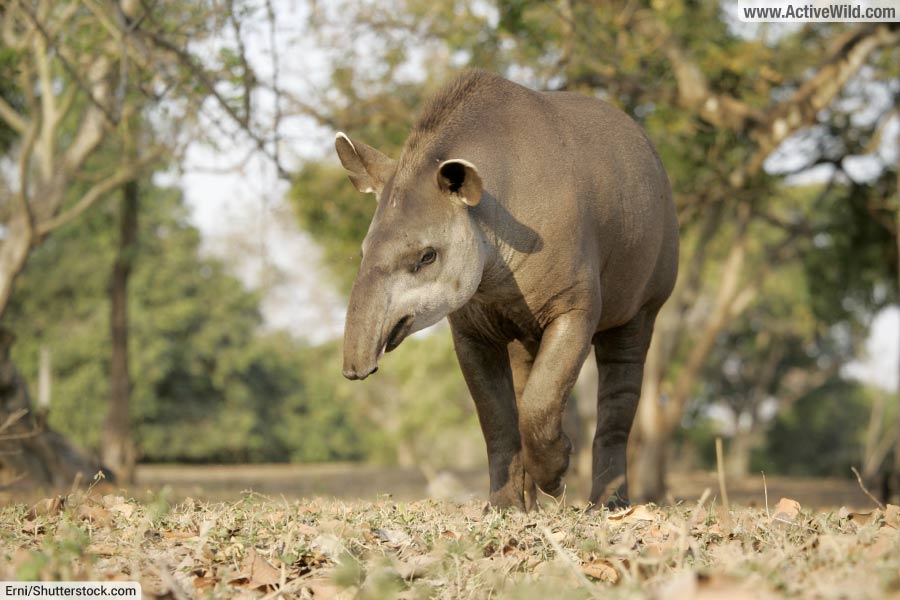
- Type of Animal: Mammal
- Family: Tapiridae
Type Of Animal: Mammal
Family: Tapiridae
Of the four tapir species, three – the South American tapir, mountain tapir and Baird’s tapir – are found in South America. (The fourth species, the Malayan tapir, is found in Southeast Asia.)
The South American tapir, which is also known as the lowland tapir and the Brazilian tapir, is the only tapir found in the Amazon rainforest, where it is the largest land mammal.
Tapirs are stocky, powerful animals with prehensile noses – using these “mini-trunks”, the tapir is able to grasp and manipulate food and other objects.
The main threats to tapirs are deforestation and hunting.
Discover More With Active Wild
You can find out more about tapirs on this page: Tapir Facts
Toucan
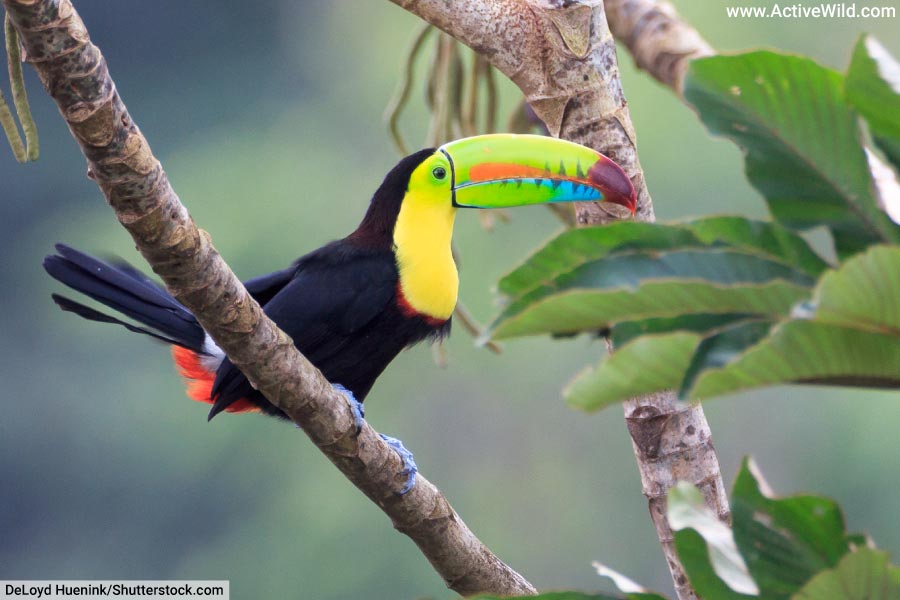
- Type of Animal: Bird
- Family: Ramphastidae
Toucans are a group of birds known for their large, brightly-colored bills and often striking plumage. The toucan family Ramphastidae contains not just the “typical” toucans – birds such as the toco toucan and keel-billed toucan – but also the toucanets and aracaris. In all, there are 43 toucan species in the family.
All toucans have distinctive large bills. Despite looking like a weapon, a toucan’s bill is lightweight, and scientists believe that its primary use may be to control the bird’s temperature. The elongated bill also allows the toucan to reach food without moving, thereby using less energy.
The toco toucan is the largest toucan. The keel-billed toucan, pictured above, is found in the tropical rainforests of Central and South America.
Discover More With Active Wild
You can find out more about toucans here: Toucan Facts
Find out more about birds on this page: Birds – The Ultimate Guide
You can find out more about the different types of birds on this page: Types of Birds
Vicuña
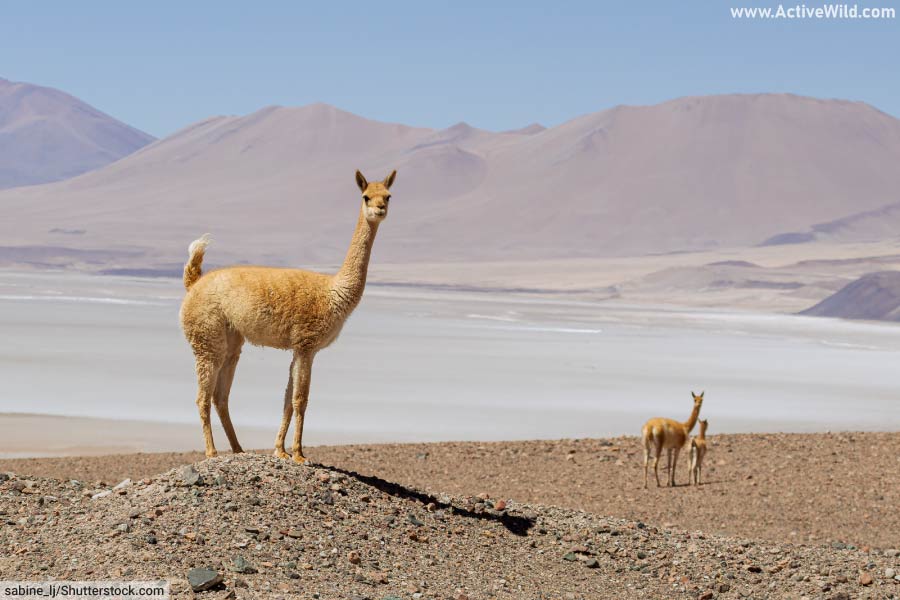
- Type of Animal: Mammal
- Family: Camelidae
- Scientific Name: Vicugna vicugna
- Conservation Status: Least Concern
The vicuña is a hooved mammal found in South America. It is a member of the camel family Camelidae, and related to the alpaca and llama, which today are both domestic animals.
The only other wild member of the camel family found in South America is the guanaco.
The vicuña is believed to be the wild ancestor of the closely-related alpaca, which was first domesticated at least 2,000 years ago.
The vicuña lives at high altitudes in the Andes, and is present in Argentina, Bolivia, Chile, Ecuador and Peru. Its wool is highly valued (the species’ domestic ancestor, the alpaca, was bred for its wool). The species is the national animal of Peru.
The vicuña became endangered in the 1970’s, when its population shrank to around 6,000 individuals as a result of overhunting.
The species’ comeback since then is a conservation success story. Today the vicuña’s conservation status is ‘Least Concern’, and its adult population numbers around 350,000.
Discover More With Active Wild
You can find out more about mammals on this page: Mammal Facts
Discover the different types of mammals on this page: Types of Mammals

